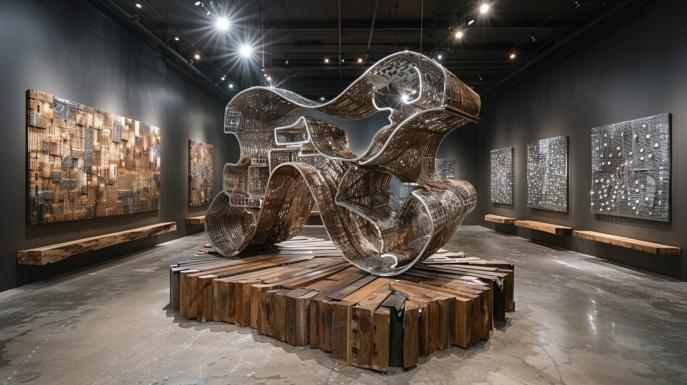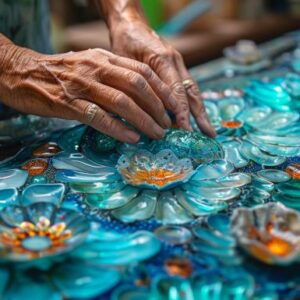Have you ever imagined transforming forgotten items into treasures full of history and style? In the world of upcycling, each object has the potential for a new life. “Upcycling: Creativity Renews the Used” is a creative odyssey, a call to rethink, reinvent and revitalize. On this journey, we will discover the immense environmental value of waste reduction, the revitalizing impact of conscious consumption, and the innovative beauty of eco-friendly design. Join us in this inspiring awakening, where every reuse is a victory for the planet and an artistic expression of the soul.
Why is upcycling important for the environment?
Upcycling significantly reduces the amount of waste going to landfills. The practice encourages conscious consumption and favors ecological design, being a form of responsible use of resources that challenges the traditional notion of disposal. By rethinking the objects and materials we already have, upcycling reinvents them as new products, valuing originality and sustainability, and thus reducing the consumption of new environmental resources.
By adopting upcycling, we are not only transforming what is old into new, but also nurturing a mentality of caring for the planet and redefining the life cycle of products. By integrating these practices into design and production, we are, step by step, paving a greener path to the future.
Where to find inspiration for upcycling projects?
Upcycling projects come to life when inspired by recycling art, transforming what is discarded into unique and desirable pieces. But where can one find such inspiration? The best sources of ideas for upcycling projects often come from online creative communities, local workshops, and platforms dedicated to sustainability and innovative design. Home upcycling ideas can flow from Pinterest pages or detailed YouTube instructions, while to improve your technique, joining sustainability-focused workshops or groups can offer support and new insights.
How to start your own upcycling project?
What basic techniques should be known for effective upcycling?
Upcycling techniques, such as creatively reusing fabrics and reinventing furniture, are essential.
To take the first step in your upcycling project, it is important to familiarize yourself with fundamental techniques such as sewing, painting and basic carpentry, depending on the type of material you want to work with. Basic tools for such transformations might include scissors, glue, brushes, and perhaps even a sewing machine or safety equipment if you plan to work with wood or metals.
The step-by-step process for creating these projects involves identifying the potential of used items, planning the design of the final product and then beginning the practice of giving new life to objects that would otherwise be discarded. The internet is full of tutorials and courses that can help beginners, and platforms like YouTube offer a vast amount of visual content for free.
Finally, it's always exciting to discover what materials you already have that could be repurposed. Common upcycling items include old clothing, furniture, cardboard, and even electronic parts._accessor
How to transform old clothes and furniture through upcycling?
Transforming used clothes into upcycled fashion pieces is simple: choose pieces you no longer use and imagine a new life for them with creative accessories, such as embroidery or a new coat of paint. When it comes to furniture upcycling, your creativity is essential to reinvent home decor. You can paint, change handles or add new fabrics to give old furniture a new character. And yes, there are countless DIY projects accessible online to guide you in transforming common objects. Venture into the world of upcycling and discover a new artistic and sustainable passion.
On this journey through the world of upcycling, we uncover its significant environmental benefits, from reducing resource consumption to integration with ecological design. Let's explore sources of inspiration to breathe new life into disused items and transform clothes and furniture into sustainable treasures. We close with a practical overview on how to start upcycling projects, both for beginners and those looking to expand their knowledge through the necessary techniques, tools and materials. May this article encourage you to embark on your own upcycling adventures, creating beauty and value while caring for our planet.
FAQ
What is upcycling and why is it beneficial for the environment?
Upcycling is a practice that transforms discarded materials or products into new ones. It is beneficial for the environment as it reduces the amount of waste in landfills, minimizes the consumption of new resources and promotes ecological design, which contributes to a more sustainable future.
Where can I get inspiration to start upcycling projects?
Inspiration for upcycling can be found in online communities, local workshops, and on platforms dedicated to sustainability and innovative design. Resources like Pinterest and YouTube are also great for finding ideas and instructions for upcycling projects.
What are the basic techniques I need to know to start an upcycling project?
To start an upcycling project, fundamental techniques include sewing, painting, and basic carpentry. These skills help transform used fabrics and furniture, and tools such as scissors, glue, brushes, and safety equipment may be necessary.
How can I transform old clothes and furniture into new items through upcycling?
To transform used clothes into upcycling fashion, add creative elements like embroidery. For furniture, experiment with painting or replacing handles. The internet offers a variety of do-it-yourself projects that can serve as a guide for these transformations.
What materials are common for upcycling projects and where can I learn more?
Common materials for upcycling include old clothing, furniture, cardboard, and electronic parts. To learn more, the internet has tutorials, courses, and platforms like YouTube offer free visual content. Start by exploring what you already have and how it can be repurposed.







